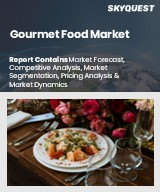
고메 식품 세계 시장 규모는 2023년 279억 3,000만 달러로 평가되었습니다. 예측 기간(2025-2032년) 동안 CAGR 7.11%로 확대되어 2024년 299억 2,000만 달러에서 2032년에는 518억 3,000만 달러로 성장할 전망입니다.
세계 고메 식품 시장은 고품질, 장인정신이 깃든 고급 식품에 대한 소비자 수요 증가로 큰 폭의 성장세를 보이고 있습니다. 가처분 소득 증가, 건강에 대한 관심 증가, 미각 취향의 진화 등이 이러한 추세를 이끄는 주요 요인입니다. 소비자들은 점점 더 진정성 있고 독특한 제품을 원하고 있으며, 이는 소매 채널, 전자상거래 플랫폼, 부티크 레스토랑을 통한 고메 식품의 매출 확대로 이어지고 있습니다. 이 카테고리는 안목과 미적 감각이 뛰어난 고객층에게 어필하며, 보다 건강한 선택과 기억에 남는 프레젠테이션을 강조합니다. 또한, 소비자들은 혼잡한 대중 식품 시장에서 유기농 및 윤리적 식재료를 사용한 선택에 매력을 느끼고 있습니다. 전문 콜드체인 솔루션의 도입은 미식 상품의 신선도를 보장하고 국경을 초월한 신뢰성을 높이는 동시에 프랑스, 독일, 이탈리아 등 요리 전통으로 유명한 국가의 전통적 맛을 선보입니다.
Global Gourmet Food Market size was valued at USD 27.93 Billion in 2023 and is poised to grow from USD 29.92 Billion in 2024 to USD 51.83 Billion by 2032, expanding at a CAGR of 7.11% during the forecast period (2025-2032).
The global gourmet food market is experiencing significant growth driven by rising consumer demand for high-quality, artisanal, and premium food products. Enhanced disposable income, increased health consciousness, and evolving taste preferences are key factors propelling this trend. Consumers are increasingly seeking authentic and unique offerings, leading to growth in gourmet food sales through retail channels, e-commerce platforms, and boutique restaurants. The category appeals to a discerning, aesthetically-minded clientele, emphasizing healthier choices and memorable presentation. Moreover, consumers are gravitating toward organic and ethically sourced options amid a crowded mass food market. The introduction of specialized cold-chain solutions ensures the freshness of gourmet items, enhancing cross-border reliability while showcasing traditional delicacies from countries known for their culinary heritage, such as France, Germany, and Italy.
Top-down and bottom-up approaches were used to estimate and validate the size of the Global Gourmet Food market and to estimate the size of various other dependent submarkets. The research methodology used to estimate the market size includes the following details: The key players in the market were identified through secondary research, and their market shares in the respective regions were determined through primary and secondary research. This entire procedure includes the study of the annual and financial reports of the top market players and extensive interviews for key insights from industry leaders such as CEOs, VPs, directors, and marketing executives. All percentage shares split, and breakdowns were determined using secondary sources and verified through Primary sources. All possible parameters that affect the markets covered in this research study have been accounted for, viewed in extensive detail, verified through primary research, and analyzed to get the final quantitative and qualitative data.
Global Gourmet Food Market Segments Analysis
The global gourmet food market is segmented into ingredients, distribution channels, products, end use, and regions. By ingredients, the market is classified as animal and plant based. Depending on the distribution channels, it is bifurcated into offline and online. According to the products, the market is divided into bakery & confectionery, beverages, cheese & dairy products, condiments, oils & seasonings, meat & seafood and snacks. as per the end user, commercial and residential. Regionally, it is analyzed across North America, Europe, Asia-Pacific, Latin America, and the Middle East and Africa.
Driver of the Global Gourmet Food Market
The Global Gourmet Food market is being driven by a growing consumer desire for unique and high-quality culinary experiences that emphasize originality and craftsmanship. This trend is fueled by the rise of food tourism, the influence of celebrity chefs, and the popularity of cooking shows and films, all of which have heightened acceptance and enthusiasm for gourmet products. Items such as artisanal cheeses, truffle oil, organic charcuterie, and handcrafted baked goods are increasingly sought after. While middle-class urban consumers express moderate interest, millennials stand out for their willingness to indulge in distinctive culinary experiences, often prioritizing spending on gourmet offerings.
Restraints in the Global Gourmet Food Market
The Global Gourmet Food market faces several restraints that hinder its growth. Gourmet foods are often characterized by labor-intensive preparation, the use of high-quality ingredients, and artisanal methods, which result in a higher cost compared to standard retail products. Consequently, their elevated prices limit their appeal to a broader consumer base, as many individuals recognize the superior quality but cannot afford to partake. Additionally, the gourmet sector offers an array of perishable products such as artisan cheeses, specialty meats, and organic pastries, which pose significant logistical and inventory challenges for distributors and retailers, further complicating market accessibility and sustainability.
Market Trends of the Global Gourmet Food Market
The Global Gourmet Food market is witnessing a significant trend towards personalization and experiential dining, fueled by advancements in artificial intelligence and consumer analytics. Brands are increasingly focusing on tailored offerings that cater to individual taste preferences, dietary needs, and unique pairings, thereby moving beyond conventional gourmet selections. Subscription models have emerged as a popular way to provide customized food experiences, curating boxes based on flavor profiles, cultural influences, or even consumers' moods. This shift is particularly driven by luxury consumers who prioritize memorable experiences over simply high-quality ingredients, redefining the landscape of gourmet dining and consumer engagement.